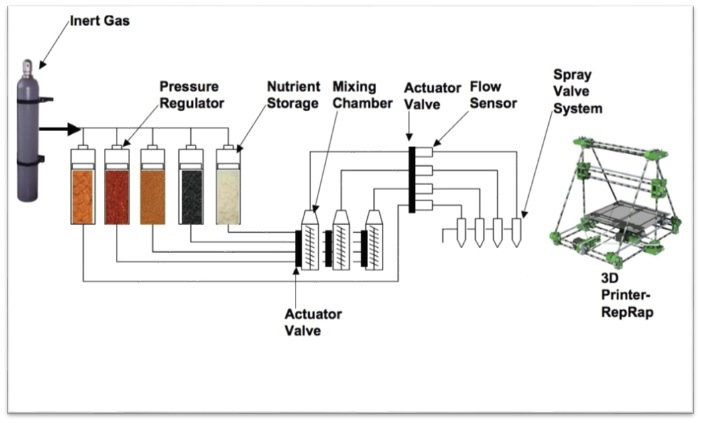3D Printing is What’s for Dinner

Basic schematic for SMRC’s food 3D printer. Courtesy of SMRC.
Latest News
May 21, 2013
Additive manufacturing (AM) seems to have its fingers in almost every pie these days. From rapid prototyping to large-scale production to medical and dental usage; 3D printing is everywhere. With that in mind, it shouldn’t really come as much of a surprise that AM has designs on your dinner plate.
Systems and Materials Research Corporation (SMRC) has received a six month, $150,000 grant from NASA to investigate the potential of using AM to build meals. The basic idea follows the standard pattern of AM. In this case, instead of slowly building up layers of metal or plastic, the RepRap style printer will build up layers of protein, sugar and carbohydrates.
NASA is interested to see if SMRC can create a system that would allow astronauts on long trips (Mars, for example) to build meals using easily stored materials with a long shelf life. SMRC planners estimate that a fully dehydrated food powder material could last as long as 30 years. It may not sound appetizing, but such a system could save valuable space onboard ship.
The first candidate for the process is pizza. A pizza is almost an ideal test candidate considering it is made in layers no matter where you order from. Just like the guy at your favorite pizza joint, the food printer would start with the crust, add some sauce and top it with something cheese-like.
Lest you think only astronauts will be alone in their consumption of this dubious delight, SMRC claims it is also looking ahead to the time when the world’s population reaches a point that current levels of food production are unable to keep pace. The company foresees a food printer in every home, printing out cheap, but nutritious, meals made from materials that won’t spoil for years.
Personally, if SMRC’s vision of food shortages comes to pass, I’ll be rooting for Organovo’s printed meat research to provide me with lunch. Bacon, even AM-produced bacon, has to be the tastier alternative.
Below you’ll find a somewhat more appetizing example of 3D printed food.
Source: Quartz
Subscribe to our FREE magazine, FREE email newsletters or both!
Latest News
About the Author
John NewmanJohn Newman is a Digital Engineering contributor who focuses on 3D printing. Contact him via [email protected] and read his posts on Rapid Ready Technology.
Follow DERelated Topics







